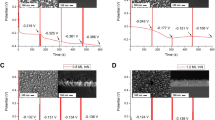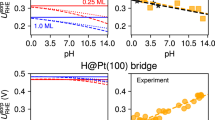Abstract
IT has been recognized for several years that when a conducting electrode is placed in an electrolyte in which there is an alternating potential gradient, it can assume a potential different from that expected1. In particular, it is generally found that the electrode potential is out of phase with the potential in the electrolyte by a variable amount. So far as I know, no explanation has been offered for the effect.
This is a preview of subscription content, access via your institution
Access options
Subscribe to this journal
Receive 51 print issues and online access
$199.00 per year
only $3.90 per issue
Buy this article
- Purchase on Springer Link
- Instant access to full article PDF
Prices may be subject to local taxes which are calculated during checkout
Similar content being viewed by others
References
Schwan, H. P., Ann. N.Y. Acad. Sci., 65, 1007 (1957).
Hognestad, H., Int. Conference Med. Electronics, Liège (1963).
Author information
Authors and Affiliations
Rights and permissions
About this article
Cite this article
WYATT, D. Directional Property of Electrode Surfaces. Nature 204, 1294–1295 (1964). https://doi.org/10.1038/2041294a0
Issue Date:
DOI: https://doi.org/10.1038/2041294a0
This article is cited by
-
Blood flow and blood velocity measurementin vivo by electromagnetic induction
Medical & Biological Engineering & Computing (1984)
-
An electromagnetic flowmeter for studying changes of cardiac output in unanaesthetized rats
Medical & Biological Engineering (1969)
-
Alternating current electrode polarization
Biophysik (1966)
-
Baseline errors in cuff electromagnetic flowmeters
Medical & Biological Engineering (1966)
-
Noise in electromagnetic flowmeters
Medical & Biological Engineering (1966)
Comments
By submitting a comment you agree to abide by our Terms and Community Guidelines. If you find something abusive or that does not comply with our terms or guidelines please flag it as inappropriate.



